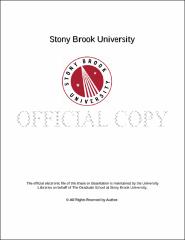| dc.identifier.uri | http://hdl.handle.net/11401/77171 | |
| dc.description.sponsorship | This work is sponsored by the Stony Brook University Graduate School in compliance with the requirements for completion of degree. | en_US |
| dc.format | Monograph | |
| dc.format.medium | Electronic Resource | en_US |
| dc.language.iso | en_US | |
| dc.publisher | The Graduate School, Stony Brook University: Stony Brook, NY. | |
| dc.type | Dissertation | |
| dcterms.abstract | The synthesis of methanol (CH3OH) from CO2 hydrogenation (CO2+3H2=CH3OH+H2O) has attracted considerable attention recently due to its industrial and environmental significance. It is a promising way to convert CO2, a greenhouse gas, into a renewable liquid fuel, CH3OH. Commercially, the reaction is conducted over a Cu-ZnO/Al2O3 catalyst under high temperature (220-240°C) and high pressure (50-100 bar) conditions, but the conversion is limited to ~20%. In this work, a combined theoretical and experimental study was carried out in order to derive general principles to improve the performance of Cu-based catalysts. Density Functional Theory (DFT) calculations were carried out to elucidate the reaction mechanism of CO2 hydrogenation on the Cu(111) surface and an unsupported Cu nanoparticle (NP). The dominant reaction pathway and key intermediates were identified. The effect of Cu NP size on the catalytic activity was revealed. iv The promotion effect by a second metal dopant towards the activity of Cu-based catalysts was also investigated. A NiCu catalyst was found to be the most promising one after screening of a series of bimetallic systems. Two descriptors were proposed to predict the catalytic activity by DFT-based Kinetic Monte Carlo (KMC) simulations. Inverse catalysts were used as model systems to study the role of the metal oxide supports towards the activity of the catalysts. Metal oxides were deposited on Cu(111) to model the oxide-Cu interface. Both small metal oxide clusters and metaloxide chain structures were included to elucidate the size effect of the metal oxide towards the promotion of methanol synthesis reaction. Ti3O6/Cu(111) shows the best activity since it can promote methanol production from two different pathways. The electronic interaction between the metal-oxide and Cu(111) was also probed experimentally using Two-photon photoemission spectroscopy (2PPE). Inverse catalysts were prepared by depositing size-selected metal oxide nanoclusters on Cu(111). The charge transfer direction and magnitude between the metal oxide clusters and Cu(111) was elucidated by a combination of DFT calculations and work function measurement from 2PPE experiments. | |
| dcterms.abstract | The synthesis of methanol (CH3OH) from CO2 hydrogenation (CO2+3H2=CH3OH+H2O) has attracted considerable attention recently due to its industrial and environmental significance. It is a promising way to convert CO2, a greenhouse gas, into a renewable liquid fuel, CH3OH. Commercially, the reaction is conducted over a Cu-ZnO/Al2O3 catalyst under high temperature (220-240°C) and high pressure (50-100 bar) conditions, but the conversion is limited to ~20%. In this work, a combined theoretical and experimental study was carried out in order to derive general principles to improve the performance of Cu-based catalysts. Density Functional Theory (DFT) calculations were carried out to elucidate the reaction mechanism of CO2 hydrogenation on the Cu(111) surface and an unsupported Cu nanoparticle (NP). The dominant reaction pathway and key intermediates were identified. The effect of Cu NP size on the catalytic activity was revealed. iv The promotion effect by a second metal dopant towards the activity of Cu-based catalysts was also investigated. A NiCu catalyst was found to be the most promising one after screening of a series of bimetallic systems. Two descriptors were proposed to predict the catalytic activity by DFT-based Kinetic Monte Carlo (KMC) simulations. Inverse catalysts were used as model systems to study the role of the metal oxide supports towards the activity of the catalysts. Metal oxides were deposited on Cu(111) to model the oxide-Cu interface. Both small metal oxide clusters and metaloxide chain structures were included to elucidate the size effect of the metal oxide towards the promotion of methanol synthesis reaction. Ti3O6/Cu(111) shows the best activity since it can promote methanol production from two different pathways. The electronic interaction between the metal-oxide and Cu(111) was also probed experimentally using Two-photon photoemission spectroscopy (2PPE). Inverse catalysts were prepared by depositing size-selected metal oxide nanoclusters on Cu(111). The charge transfer direction and magnitude between the metal oxide clusters and Cu(111) was elucidated by a combination of DFT calculations and work function measurement from 2PPE experiments. | |
| dcterms.available | 2017-09-20T16:52:08Z | |
| dcterms.contributor | White, Michael G. | en_US |
| dcterms.contributor | Rodriguez, Jose | en_US |
| dcterms.contributor | Liu, Ping | en_US |
| dcterms.contributor | Johnson, Philip | en_US |
| dcterms.contributor | Li, Yan. | en_US |
| dcterms.creator | Yang, Yixiong | |
| dcterms.dateAccepted | 2017-09-20T16:52:08Z | |
| dcterms.dateSubmitted | 2017-09-20T16:52:08Z | |
| dcterms.description | Department of Chemistry. | en_US |
| dcterms.extent | 149 pg. | en_US |
| dcterms.format | Monograph | |
| dcterms.format | Application/PDF | en_US |
| dcterms.identifier | http://hdl.handle.net/11401/77171 | |
| dcterms.issued | 2013-12-01 | |
| dcterms.language | en_US | |
| dcterms.provenance | Made available in DSpace on 2017-09-20T16:52:08Z (GMT). No. of bitstreams: 1
Yang_grad.sunysb_0771E_11540.pdf: 5463086 bytes, checksum: 59d9ee5bb7308b0c259f62e857c17a1e (MD5)
Previous issue date: 1 | en |
| dcterms.publisher | The Graduate School, Stony Brook University: Stony Brook, NY. | |
| dcterms.subject | Chemistry | |
| dcterms.title | Rational Design of Cu-based Nanocatalysts for the Production of Methanol | |
| dcterms.type | Dissertation | |

